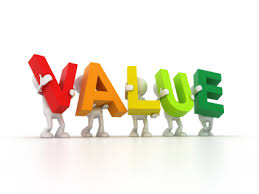1/28: The most commonly debated and IMHO the least grounded topic in early stage VC is “how do you determine what a company is worth?” Recent early stage #fintech and #venturecapital valuations seem to defy gravity but are they justified?
2/28: Answering this question requires breaking down the problem into a framework that’s easier to analyze. One framework: A business is “worth” a combination of the intrinsic value of what it can produce and the option value of what it might be able to produce in the future.
3/28: When a company has cracked the code on turning a dollar of investment into a multiple of the dollar in the future it can be categorized as a money making machine.
4/28: Every money making machine has some intrinsic value. The value is a function of the return profile of the future cash flows, the certainty of the cash flows, and the amount of money the machine can put to work.
5/28: In contrast to the intrinsic value of a company, the option value of a company is based on unknowns vs. knowns. It’s about belief vs. proof, narrative vs. result and “if” statements vs. “look” statements.
6/28: The public markets have historically been good at valuing money making machines especially when they’re in mature ecosystems with easy to analyze competitive landscapes.
7/28: The public markets have historically been poor at valuing the option of value of a company, especially when there are many necessary leaps of faith and a company is still burning cash.
8/28: The most polarizing of public companies are those like @Tesla and @onepeloton where some investors are willing to ascribe significant value to the “option value” of the company while others aren’t.
9/28: Strategic buyers are also good at valuing the intrinsic value of a company and are even good at valuing potential synergies. But only some are willing to ascribe significant value to the “option value” of what can be built.
10/28: But for early stage private markets investors, valuation analysis requires nailing down how much you’re willing to pay for the intrinsic value and how much you’re willing to pay for the option value of a company.
11/28: When evaluating the intrinsic value of a company, the most important question to answer is “what does the business know how to do with repeatability?”
12/28: Traction doesn’t directly equate to the value of “still being figured out businesses”. Learnings are important and need to be examined in depth before value can be ascribed to them.
13/28: Today’s traction is merely shorthand proof for what the company has learned in the market. Just because a business has more customers or more revenue than it did in the past doesn’t imply the business is worth more.
14/28: And this is one area where things have broken down in the VC community. For instance, many Seed stage companies have been given the bad generic advice that getting to a $1MM ARR equates to product market fit.
15/28: Many early stage companies growth hack their way into early revenue and in many cases, the way they scale to $1MM ARR has nothing to do with what they’ll need to do to scale to $10MM ARR.
16/28: The company might learn how hand-picked customers behave and it might learn if its product is buggy or is working the way it intends it to.
17/28: But, because it wants to show instant growth, it doesn’t always take the time to learn about putting money to work in scalable marketing channels or how general market customers behave.
18/28: If a direct competitor showed up with $250K of ARR but with evidence that it could put a significant amount of money to work with great returns in very deep and scalable channels, it should be more valuable than the first company.
19/28: Sadly, many members of the Venture Community are agreeing less and less with this theory. The view I’ve heard over and over is that team and momentum matter more than business model and learnings.
20/28: And what’s emerging more and more in the Venture world is a class of company that’s structured to burn cash to grow without having very defined theories for how money is made.
21/28: In today’s hot market, every time money is raised valuations seem to grow by 2-3X when it’s unclear the intrinsic value plus the option value is 2-3X greater than it was when the last money was invested in the company.
22/28: Eventually the piper needs to get paid and a company will be valued by disciplined investors. So unless your check is the last check a company needs and you have an unlimited hold period you need to understand how it will eventually be valued.
23/28: What confuses the analysis is that the right hand tail of outcomes is virtually uncapped. This means that any investor who invests in a company “far to the right” can get everything else wrong and still produce great portfolio returns.
24/28: But it also means that baking this potential into the option value of a company results in overpaying for a portfolio of companies if it doesn’t contain a “far to the right” company.
25/28: My general takeaway is that in today’s market, private investors are overvaluing the option value of a company because they’re overconfident that they can find right hand tail companies.
26/28: Very few firms can find and invest in a “return the fund” company every 2-3 years which is what it takes to make the math of valuing the “far to the right” tail into one’s valuation work.
27/28: But for those firms that routinely invest in the massive winners (nod to @felicis, @sequoia, @IndexVentures, @Accel and @iaventures) they might just have it right.
28/28: I wrote more on this topic at: http://fintechjunkie.com/2019/10/25/buying-a-cash-making-machine/.">https://fintechjunkie.com/2019/10/2... And remember, re-tweeting is how this stays alive!

 Read on Twitter
Read on Twitter


